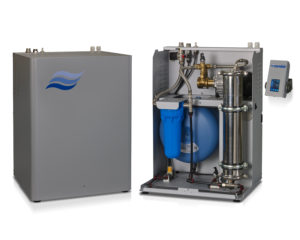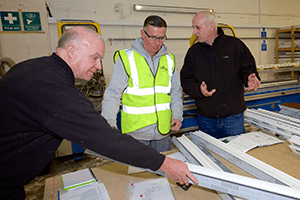Monthly Archives: January 2018
Should RCBOs be considered compulsory for residential housing stock?
Story

As the latest revision of the IET Wiring Regulations (the 18th Edition) looms large, Dave Enefer of Crabtree asks whether RCBOs should be considered compulsory for all circuits in residential housing, especially given the evidence of the benefits of Miniature RCBOs to personal safety of occupiers & electrical operatives.
Public awareness of electrical faults and accidents has arguably never been higher. Even with all the advances in electrical safety technology and hardware there’s still room for improvement in take up of use of these technologies. Electrical dangers can come from many sources but when they do they shouldn’t bring with them added risk or inconvenience.
Why use Miniature RCBOs?
For any landlords, tenants, homeowners or those uninitiated in electrical products, RCBO stands for Residual Current Circuit Breakers with Overcurrent Protection. These devices are a combination of an RCD (Residual Current Device) and MCB (Miniature Circuit Breaker) in one.
In layman’s terms, an RCD detects Earth Leakage, i.e. current flowing where it shouldn’t, switching the circuit off where there is an Earth fault current. The RCD element of the RCBO is there to protect people.
In housing installations it’s not unusual to find that one or more RCDs are used alongside MCBs in the consumer unit, all grouped together protecting multiple circuits. What commonly happens when there is an earth fault on one circuit is the that a whole group of circuits, including healthy circuits, are switched off.
In these instances, using RCDs and MCBs in groups goes against specific aspects the IET’s 17th Edition Wiring Regulations. Specifically, Chapter 31 – Division of Installation, regulation 314.1, which requires every installation to be divided into circuits as necessary –
- To avoid danger in the event of a fault
- To facilitate safe inspection, testing and maintenance
- To take account of hazards that might arise from the failure of a single circuit e.g. lighting circuit
- To reduce the possibility of unwanted tripping of RCDs (not due to fault)
The above requirements cannot all be adequately provided for if groups of circuits are all connected to one or two RCDs in a consumer unit.
For instance, let’s take a scenario with an electrical shower, a common fixed electrical appliance in many homes. It wouldn’t be safe for the bathroom lighting circuit to be tripped off because of a single fault related only to the electric shower. The occupant would be plunged into darkness while in a wet and slippery environment. Both of these hazards being introduced following the reaction of an RCD to a single fault directly contravenes points 1 and 3 of avoiding danger.

Point 4 is more pertinent than ever these days as an increasing number of appliances place heavier demands upon circuits. Unwanted, or nuisance, tripping is far more likely to occur if we have one 30mA RCD protecting multiple circuits. As more and more electrical equipment is used within modern homes the likelihood of cumulative circuit protector currents (earth leakage likely to occur during normal operation) reaching a level sufficient to trip a 30mA device becomes a real risk.
Point 2, to facilitate safe inspection & testing is equally difficult to achieve. For instance is it safe if the lighting has to be off while the sockets are being tested. Clearly the most compliant way to accommodate Chapter 31 is to avoid grouping circuits on to one or even two RCDs and instead provide separate electrical protection by individual RCBOs for each circuit. Under these circumstances all healthy circuits will remain in service.
Go further by switching off line and neutral
Facilitating safe inspection and maintenance can be time-consuming for electricians, even with RCBOs, unless those RCBOs switch both Line & Neutral.
Typically with RCBO protected circuits, the outgoing cables and flying leads have to be disconnected and then reconnected when undertaking insulation resistance tests. This is very time consuming, but by using an RCBO with switched line and neutral it is not necessary to disconnect the circuit. Simply switch off the RCBO and the circuit is instantly isolated and ready for test.
For social housing landlords, having an obligation to regularly test large quantities of installations, this type of RCBO can save time, money and provide a safer environment while fully meeting requirements of the IET wiring regulations; in particular the need for maintaining power continuity under fault conditions. RCBOs that switch both line and neutral, either in the event of a fault or to facilitate maintenance, totally isolate the circuit in question. This provides the occupier with a safe environment while they await the emergency electrician, any fault is completely isolated and all other healthy circuits remain in working order.
Miniature means Miniature
Another area where developments in RCBO design can make a real difference is in their size. Miniature RCBOs are the same size as a miniature circuit breaker, one module wide and only 90mm tall. This gives installers almost 30% more wiring space within a consumer unit. When considered along with long standing Starbreaker ‘plug in’ technology this makes for a quicker, easier, safer installation.
As part of its commitment to improving user safety and installer convenience, Crabtree has now developed the Starbreaker Miniature RCBO. This is safer because it switches both live & neutral, and at no extra cost. Totally isolated circuits cater for Health & Safety at work for electrical operatives whether they are conducting periodic testing, fault finding, replacing damaged accessories, extending or adding to circuits. Totally isolating faults provides a safer living environment for occupiers at times when things go wrong and the emergency electrician is on the way.
View Crabtree's profile:
New Condair RO for Better Humidity Control
Story

Condair is launching the Condair RO-A reverse osmosis water filter, specifically designed for use with humidification systems. The Condair RO-A removes 95% of dissolved solids from a humidifier’s supply water in order to reduce maintenance, improve energy consumption and benefit ongoing running costs.
When operating on regular mains water, a steam humidifier will frequently need to drain hot water and replace it with fresh, in order to dilute mineral levels in the boiling chamber. This process requires more energy to heat the incoming cold water. It also impacts humidity control, as when the boiling chamber’s temperature drops so does the steam output. By operating a steam humidifier on reverse osmosis (RO) water from a Condair RO-A, these drain cycles are reduced by up to 97%. This in turn reduces energy and water consumption of the humidifier and enables a close humidity control of up to ±1%RH.
With the use of virtually mineral-free RO water, the lime scale build-up inside a steam humidifier’s boiling chamber is minimal, reducing humidifier servicing requirements. When used with evaporative humidifiers, this reduction in lime scale formation results in evaporative pads having a much longer lifetime. The required frequency of an evaporative humidifier’s water tank drain cycles is also reduced, saving water. Operating spray humidifiers on RO water prevents dust from precipitating into the atmosphere as the spray evaporates, improving the performance of the system.
The Condair RO-A has been designed to deliver water at an ideal quality for humidification systems, whilst minimising waste water from the RO process. Many standard RO water filters provide product water at a purity that is much greater than that required to benefit humidifiers. The high purity means more water is sent to drain during the RO process to achieve a very low mineral content. By typically removing only around 95% of the minerals, the filtered RO water effectively provides significant benefits to humidification systems with minimal water being sent to drain.
Four models are available in the Condair RO-A range, with maximum outputs of 40, 100, 200 and 300 litres per hour. The 40 and 100 litres per hour models have an integrated water tank and a single RO membrane. The 200 and 300 litres per hour models have two or three RO membranes and an external water tank with up to 100 litre storage.
An independent wall-mounted touch screen controller provides an intuitive user interface with comprehensive reporting features. Alternatively the Condair RO-A can be controlled from any Condair humidifier that incorporates a Condair touch-screen control panel.
The Condair Group is the world’s leading specialist in humidification and evaporative cooling, with energy efficient, hygienic and innovative technologies for commercial, industrial and heritage applications. Condair is represented in the UK by Condair plc, which offers system design, manufacture, supply, installation, commissioning, maintenance and spares. Condair plc is the new name for JS Humidifiers following the organisation’s rebranding in October 2014. You can find out more by visiting the company’s website at www.condair.co.uk.
View Condair's profile:
AGILA OPENS UP NEW OPPORTUNITIES FOR FABRICATORS
Story

Since REHAU launched its AGILA sliding doors range sales of the PVC-U doors have been steadily growing and now more fabricators than ever are choosing to specify AGILA.
AGILA sliding doors are great for modern living, letting in light and creating openness in any space. They can be installed as a traditional patio door, entrance door or door to a conservatory, and are available in eight different colour options to provide a flexible solution which can be tailored to the individual needs of the customer. A perfect fit for REHAU’s popular TOTAL70 windows system, the AGILA sliding door also offers continuity of product across larger specifications.
As well as slimmer sightlines and superior aesthetics, AGILA sliding doors are incredibly energy efficient, with a triple glazing option on offer. They also come with enhanced security options and benefit from ERA’s new Total Security Guarantee for complete peace of mind.

Currently there are ten businesses fabricating the AGILA Sliding Door across the UK and Ireland. These include Climatec, Fenster Trade Frames, GRM, Polyframe, Euroglaze, Stormking, Hadrian, Costello PVC, O’Grady UPVC Ltd and Caledonia Doors in Cumbernauld being the most recent company to come on board .
To increase interest further, REHAU has released a new video online which highlights all the great features of the AGILA sliding doors to promote the product to fabricators and their customers.
Clare Higgins, Product Manager, from REHAU said: “The AGILA sliding door has been a fantastic addition to our doors offer, providing our partners with a high quality and flexible door solution they can offer to their customers individually or as part of a full portfolio of REHAU products. With the trend for large span doors continuing to gather pace in the domestic market, we expect to see even more contractors choosing to offer our sliding doors over the coming months and years.”
For further information please visit www.rehau.uk/agila.


